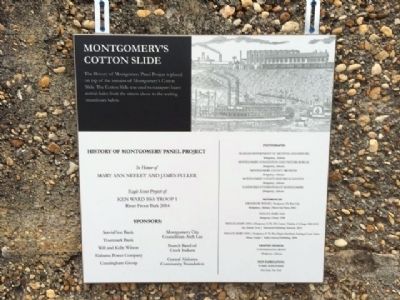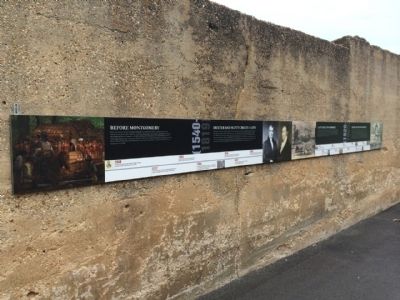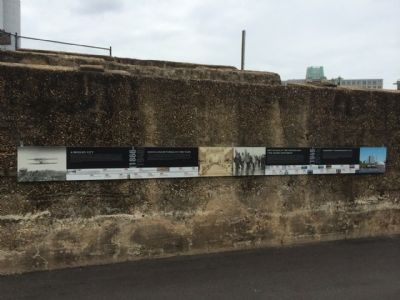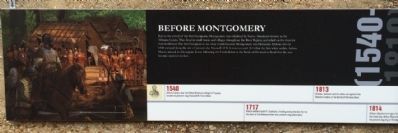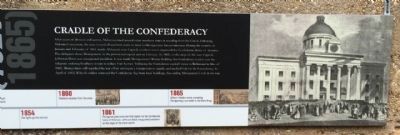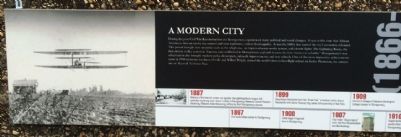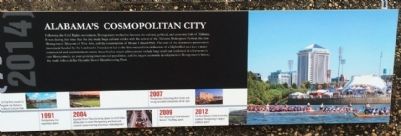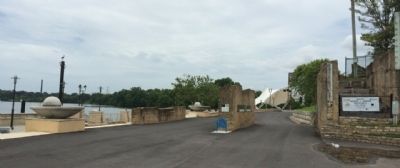Montgomery in Montgomery County, Alabama — The American South (East South Central)
Montgomery's Panel Project
Montgomery's Cotton Slide
The history of Montgomery Panel Project is place on top of the remains of Montgomery's Cotton Slide. The Cotton Slide was used to transport heavy cotton bales from the streets above to the waiting steamboats below.
Before Montgomery
Before the arrival of the first Europeans, Montgomery was inhabited by Native Americans known as the Alibamu Creeks. They lived in small towns and villages throughout the River Region, and relied on the river for their livelihood. The first European to see what would become Montgomery was Hernando DeSoto who in 1540 camped along the site of present-day Maxwell AFB. It was not until 1814 that the first white settler, Arthur Moore, moved to this region. It was following the Creek defeat at the Battle of Horseshoe Bend that the area became open for settlers.
Dexter and Scott Create a City
Following the opening of the Alabama Territory, many hoped to gain their own chance at cheap, fertile land. Sold at a Georgia land office, the area that would become Montgomery was a favorite among purchasers. The land was purchased by two men, each wanting to create their own settlement: Andrew Dexter, a Massachusetts lawyer and John Scott, a Georgia planter. With others they established two villages, New Philadelphia and East Alabama Town. It was said that one settlement had city services and the other had merchants, but both fought to be the one to succeed. Following intense competition the towns incorporated on December 3, 1918, forming Montgomery, named after General Richard Montgomery, a Revolutionary War hero.
A City Built on Commerce
Due to its geographic location, Montgomery quickly became a center of commerce and government in the fast-growing central Alabama region. It was at this time that the first of many riverboats, the Harriott, arrived and transformed Montgomery into an important regional hub for the shipping, trading, and storing of cotton and many other important commodities. It was only a year later that the first courthouse was built, making the city a political hub. This period also brought the first hotels, churches, and businesses to the city. Finally in 1845 the Alabama Legislature voted to move the state capital to Montgomery, transforming the city into an important political center.
Cradle of the Confederacy
After years of division and unrest, Alabama joined several other southern states in seceding from the Union. Following Alabama’s secession, the state invited all southern states to meet in Montgomery for a conference. During the months of January and February of 1861, inside Alabama’s state Capitol, southern states organized the Confederate States of America. The delegates chose Montgomery as the provisional capital and on February 18, 1861, on the steps of the state Capitol, Jefferson Davis was inaugurated president. It was inside Montgomery’s Winter Building that Confederate leaders sent the telegram ordering Southern troops to reduce Fort Sumter. Following the Confederate capital’s move to Richmond in May of 1861, Montgomery still supplied the war effort serving as a transportation, supply, and medical hub for the Confederacy. In April of 1865, Wilson’s Raiders removed the Confederate flag from local buildings, thus ending Montgomery’s role in the war.
A Modern City
During the post Civil War Reconstruction era Montgomery experienced many political and social changes. It was at this time that African Americans sat on the city council and state legislature, a short lived equality. It was the 1880s that started the city’s economic rebound. This period brought new amenities such as the telephone, an improved water works system, and electric lights. The Lightning Route, the first electric trolley system in the America, was established in Montgomery and with it the first “street-car suburbs.” Montgomery’s new urbanization also brought modern parks, skyscrapers, sidewalk improvements, and new schools. One of the most impressive achievements came in 1910 when two brothers, Orville and Wilbur Wright, started the world’s first civilian flight school on Kohn Plantation, the current site of Maxwell Air Force Base.
Montgomery's Role in the Wars
Montgomery played major roles in both WWI and WWII. This was mainly due to the many major military facilities organized in the city. During the first World War, Camp Sheridan, an infantry training center north of town and Ardmont, an air repair depot located on the site of the former Wright Flight School, both played pivotal roles in preparing America for its first modern war. It was while at Camp Sheridan that author F. Scott Fitzgerald met local socialite Zelda Sayre. It was during the 1920s that Ardmont became known as Maxwell Field. During the second World War, Maxwell Field and Montgomery’s municipal airport, Gunter Field, became important military aviation centers. After the war Maxwell became home to the Air University.
Birthplace of the Modern-Day Civil Rights Movement
After years of segregation and second-class citizen treatment of African Americans, Montgomery became the fighting grounds for several key battles of the Civil Rights Movement. Montgomery’s role began in 1955 when a local seamstress, Rosa Parks, was arrested after she refused to give up her seat to whites on a city bus. This encouraged local African American leaders to lead the Montgomery Bus Boycott, a movement organized by the Montgomery Improvement Association. Their boycott paid off in 1956 when bus segregation was finally outlawed, encouraging other movements. In 1961, one hundred years after the formation of Confederacy, a group of young protesters called the Freedom Riders, were assaulted at the Montgomery Greyhound Bus Station while protesting illegal racial segregation present in many public facilities. In 1965 Montgomery was once again in the spotlight when Dr. Martin Luther King Jr., and other civil rights leaders led a march from Selma to Montgomery to protest Jim Crow era voting laws which prohibited many African Americans from casting ballots. Their actions eventually convinced Congress to pass the Voting Rights Act which changed the face of politics throughout the country.
Alabama's Cosmopolitan City
Following the Civil Rights movement, Montgomery worked to become the cultural, political, and economic hub of Alabama. It was during this time that the city made huge cultural strides with the arrival of the Alabama Shakespeare Festival, the new Montgomery Museum of Fine Arts, and the construction of Blount Cultural Park. The start of the downtown preservation movement headed by the Landmark Foundation led to the first successful revitalization of a blight-filled area into a major commercial and entertainment center. Several other major achievements include large retail and residential developments in east Montgomery, an ever growing international population, and the largest economic development in Montgomery’s history, the multi-billion dollar Hyundai Motor Manufacturing Plant.
Erected 2014 by the Ken Ward BSA Troop 1, River Front Park Eagle Scout Project.
Topics. This historical marker is listed in these topic lists: African Americans • Civil Rights • Settlements & Settlers • War, US Civil. A significant historical month for this entry is February 1861.
Location. 32° 22.929′ N, 86° 18.807′ W. Marker is in Montgomery, Alabama, in Montgomery County. Marker can be reached from the intersection of Commerce Street and Water Street. Take the Riverfront tunnel down to the Alabama River. Panels are on the right. Touch for map. Marker is at or near this postal address: 355 Commerce Street, Montgomery AL 36104, United States of America. Touch for directions.
Other nearby markers. At least 8 other markers are within walking distance of this marker. High Red Bluff (a few steps from this marker); Major Charles W. Davis, Infantry United States Army / "Above and Beyond" (a few steps from this marker); Struggle For Colonial Empire (about 300 feet away, measured in a direct line); Montgomery (about 300 feet away); The Domestic Slave Trade / Slave Transportation to Montgomery (about 400 feet away); Transportation and Commerce (about 400 feet away); Encanchata (about 500 feet away); Train Shed 1897 (about 500 feet away). Touch for a list and map of all markers in Montgomery.
More about this marker. The panels include a timeline at the bottom.
Also see . . . Montgomery Advertiser article and video about project. (Submitted on June 28, 2014, by Mark Hilton of Montgomery, Alabama.)
Credits. This page was last revised on September 7, 2020. It was originally submitted on June 28, 2014, by Mark Hilton of Montgomery, Alabama. This page has been viewed 746 times since then and 38 times this year. Last updated on October 20, 2014, by Mark Hilton of Montgomery, Alabama. Photos: 1, 2, 3, 4, 5, 6, 7, 8, 9, 10, 11, 12. submitted on June 28, 2014, by Mark Hilton of Montgomery, Alabama. • Bill Pfingsten was the editor who published this page.
